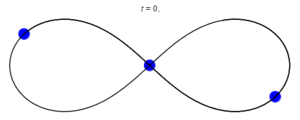Three-body problem facts for kids

The three-body problem is a puzzle in physics. It asks how three objects move when they all pull on each other with gravity. Imagine trying to figure out the exact paths of the Sun, the Earth, and the Moon all at once! Scientists have found that there isn't one simple answer that works for every situation.
Moving at Normal Speeds
When objects move at everyday speeds, far slower than the speed of light, we call this "non-relativistic movement." The speed of light is the fastest speed anything can travel. For these normal speeds, we use classical mechanics, which are the rules of motion discovered by Isaac Newton.
To understand how these objects move, scientists need to know where each object is, how fast it is going, and how much mass it has. Then, using Newton's laws of motion, they can predict the paths the objects will take.
Moving at Very High Speeds
When objects move extremely fast, close to the speed of light, things get more complicated. This is where Albert Einstein's theory of Relativity comes in.
In this situation, objects can create waves of gravity. When they do this, they lose some of their energy. This makes it much harder to calculate their exact movements. It means the system is "not conservative" because energy is leaving the system.
There is no simple, general solution for the movement of two or three objects when they are moving at these very high, relativistic speeds.
In Space
The three-body problem is very important in astronomy. It helps us understand how planets, moons, and stars move in space. Isaac Newton was the first to talk about this problem in his famous book, Principia.
Often, in space, two of the objects are very large, like two stars, and the third object is much smaller, like a planet. Sometimes, if the objects have the same mass and pull on each other equally, scientists can find an exact solution. But usually, they have to use special math tools like iteration and approximation. This means they make educated guesses and then improve those guesses step by step until they get a very close answer. Many different patterns of motion can happen when three objects interact this way.
See also
 In Spanish: Problema de los tres cuerpos para niños
In Spanish: Problema de los tres cuerpos para niños

